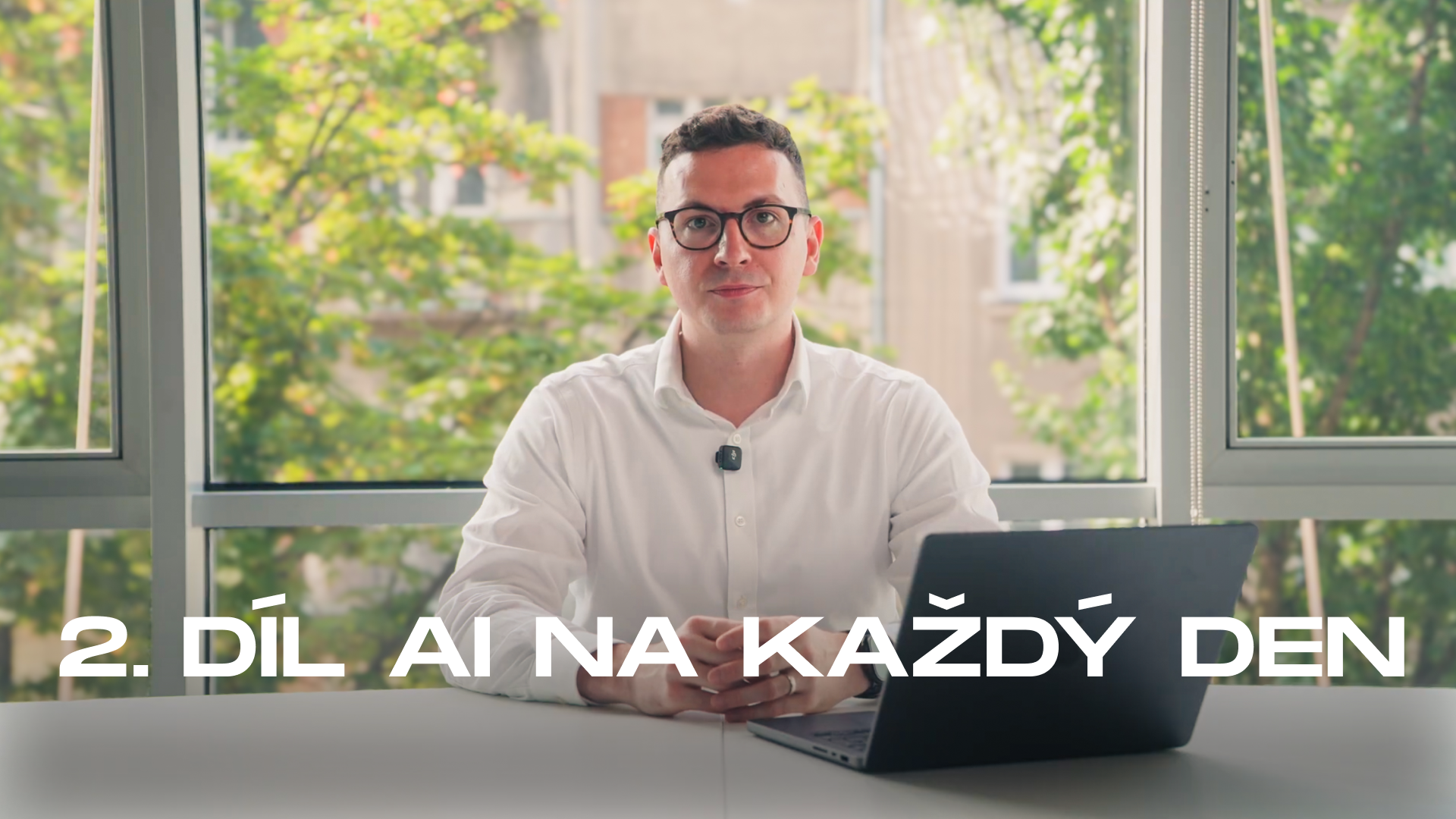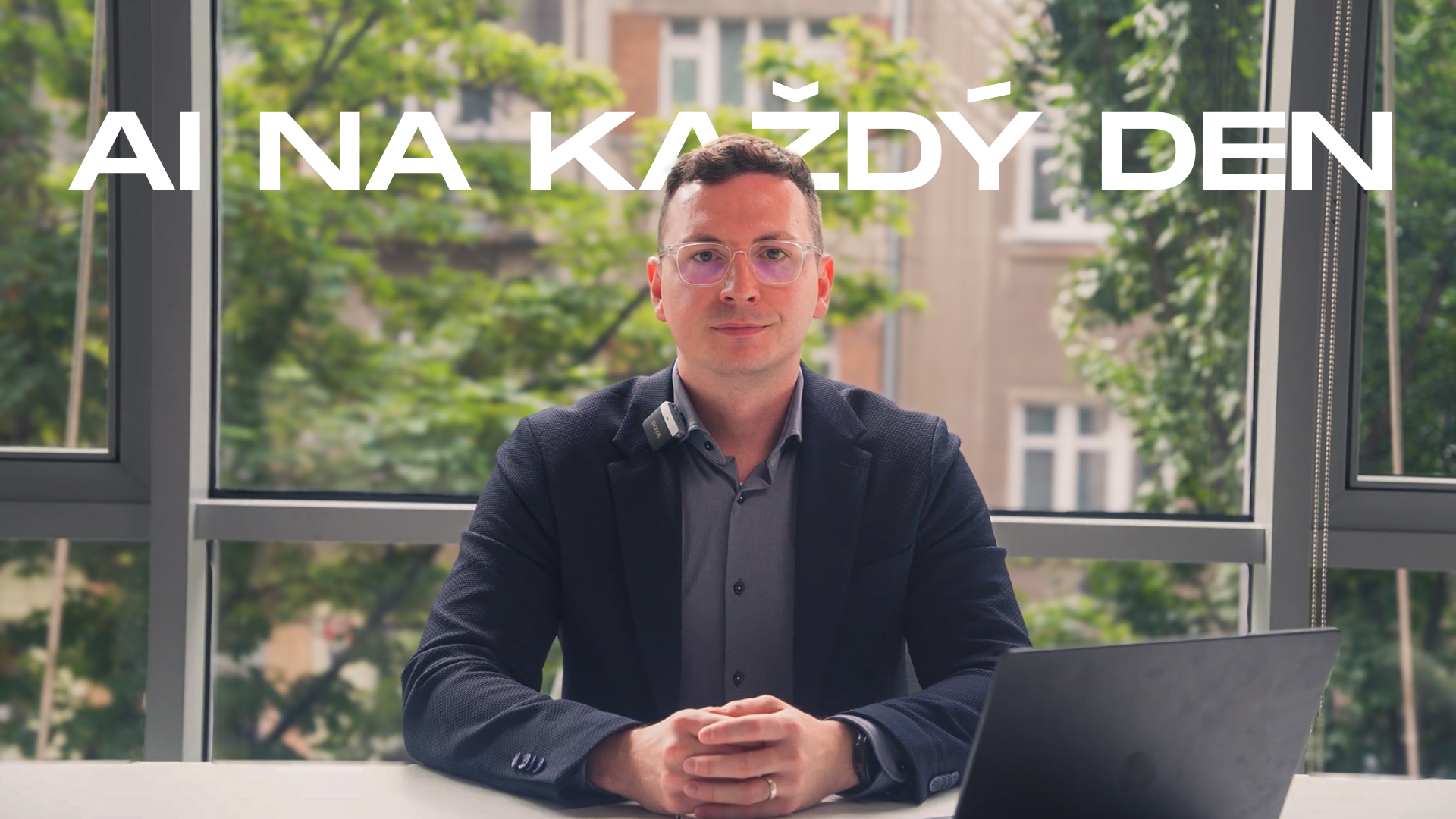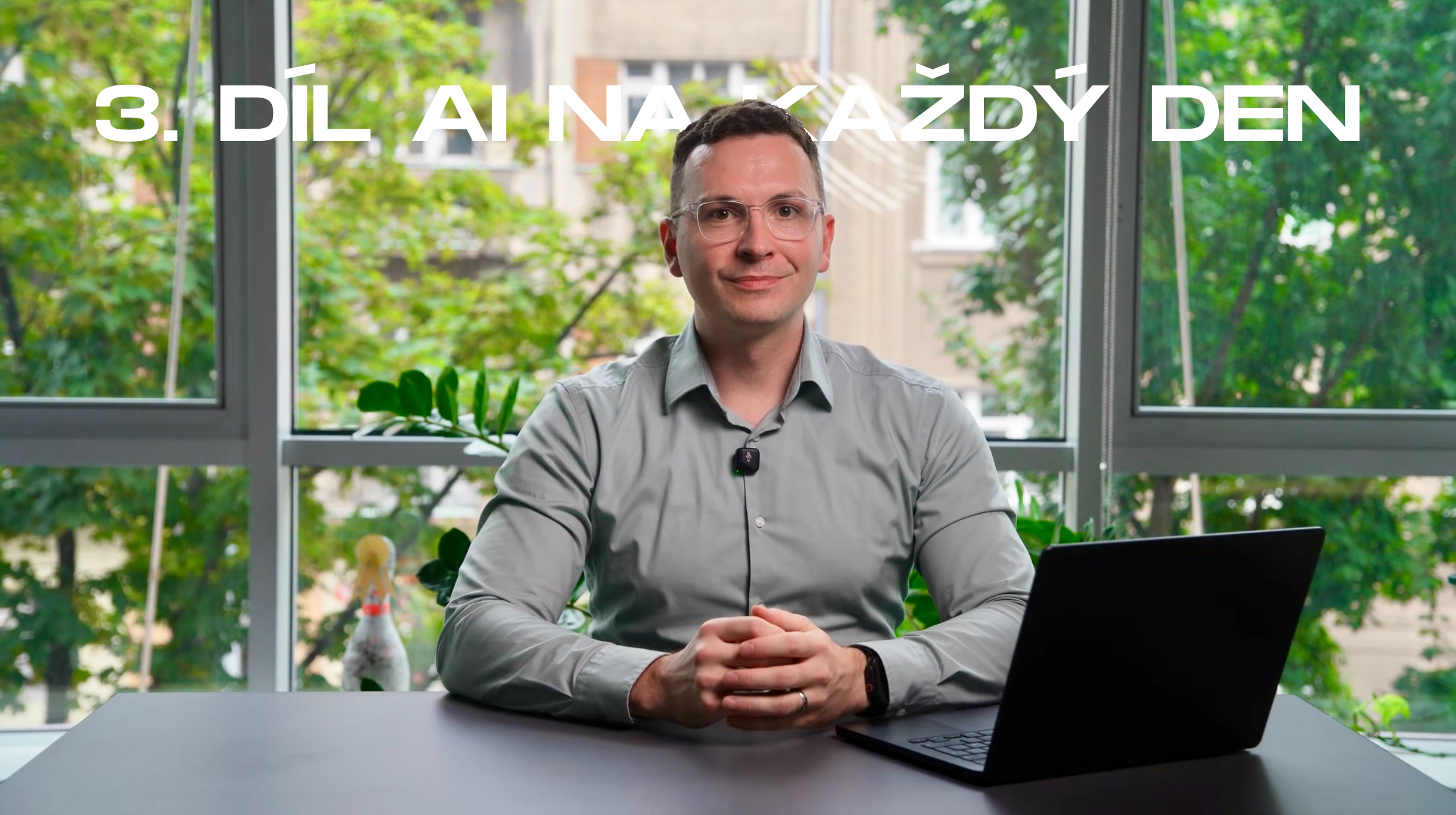How much time per week do you spend writing emails, reports or editing texts? What if you could do it in half the time with AI – without stress and without thinking about every sentence?
In the last episode, we showed you how to get started with AI. Today, we’re going to focus on one of the most practical areas where you can start using it now – working with text. Emails, contracts, posts, translations, text editing or even brainstorming. Most of what we’re tediously tapping on the keyboard today, AI can either do for us or help us significantly.
As we said last time, AI works best in combination with humans. Think of it as a handy colleague that you need to check up on from time to time – but who can save you a lot of work and offer a fresh perspective.
BEFORE YOU BEGIN: Most AI tools have terms and conditions that state that if you publish text or images created using them, you must indicate this. So when using AI, remember to give fair attribution for the content you generate.
And to be transparent: generative artificial intelligence helped me to work with the text and to find themes while writing this article.
Video for this episode of the series
If you have trouble playing the video here, try opening it directly on the YouTube website.

About the author
At Gappex, Tomáš Rolc develops the business side of the SmartFP platform, which helps companies digitise processes using a low-code approach. He strives to connect technical knowledge with business and focuses on making SmartFP accessible and understandable to as many users as possible.
Let’s take a look together at how AI makes text easier to work with
The purpose of this episode is to show how artificial intelligence can make your daily work with various texts easier. AI is a great helper – it makes routine tasks easier, opens up new possibilities and lets you focus on more important work. You don’t need to be afraid of it, you just need to know what to expect from it and what not to expect.
The basic rule of thumb, as in the last episode, is: the best AI is not AI alone, but a combination of AI and humans. Artificial intelligence can analyse text in a flash, suggest a solution or formulate an answer. But without a clear task, goal and human control, it cannot manage on its own. In practice, it works best when a human sets the direction and AI helps along the way – looking for options, evaluating and suggesting. AI won’t do the job for you completely on its own, but if you use it correctly, it can help you be significantly more efficient – faster, more consistent and even more creative. That’s where its greatest benefit lies.
Example of using AI 1/10:
Writing emails quickly and easily
Do you spend hours debugging your emails and worry that there are still mistakes left in them? Try involving AI in the process – for example, ChatGPT can write an entire email from scratch based on your input. Just give it a good prompt or the brief: describe who you’re writing to and for what purpose, what style the email should be, and what the goal is. ChatGPT will generate a draft email accordingly in no time.
Navrhni text obchodního e-mailu jako odpověď na žádost o více informací o naší platformě SmartFP, která slouží k digitalizaci firemních procesů. V e-mailu chci nabídnout schůzku, ale pokud adresát nebude mít čas, rád bych mu poslal několik otázek, které mi pomohou připravit prezentaci nebo nabídku na míru.
Cílem e-mailu je přirozeně motivovat klienta k domluvě schůzky, nebo alespoň k odpovědi na otázky. Styl by měl být profesionální, lidský, lehce neformální — používej moderní obchodní jazyk bez vlezlosti. Do e-mailu neuváděj podpis.
Než začneš psát samotný e-mail, zeptej se mě nejprve na jméno adresáta a termíny, které mám k dispozici pro schůzku.Review the generated email carefully and edit or add details. If you leave anything out, the AI may ask you questions – for example, who the recipient is or what meeting dates work for you. Once the AI has completed the email, just review the draft and you’re ready to send it.

Tip: You can have the AI edit the finished email for language or, for example, change the style from a formal greeting to a more friendly nod. To do this, you use another simple prompt – e.g. “Convert the text to a less formal form, but keep the professional tone.” ChatGPT will rewrite the email into the desired style in a few seconds, so you can use it for a client you’re teasing, for example.
S adresátem si tykám. Přepiš text do moderního obchodního jazyka, používej tykání a oslovuj adresáta křestním jménem. Styl by měl být profesionální, přirozený a lehce neformální. Vyhni se příliš familiárnímu nebo neprofesionálnímu tónu.If you’re uncomfortable letting AI write the entire email for you, you can use it in other ways. Write the email yourself and then ask the AI to “polish” it – that is, correct wording, typos and improve clarity. Personally, I use a custom universal prompt to do this, in which I tell ChatGPT that I want to correct grammar, wording, and preserve the formatting of the text. ChatGPT requests the email text I need to edit, I paste it in – and get back a vastly improved version. After AI intervention, the email is easy to read, properly formatted, while still retaining my original style and substantive content.
Uprav prosím následující text tak, aby byla zachována veškerá původní sdělení, ale vylepšena gramatika a slovosled. Použij lehce formální, moderní obchodní jazyk, který působí lidsky. Nepoužívej zvýraznění oslovení, ikony ani jiné speciální prvky, pouze základní formátování textu. Nejdříve mě výzvy k zadání textu.
Následuje text vašeho emailu.You can see that the AI can handle text full of typos or bad formatting. It corrects and tweaks it in seconds so that the resulting email looks professional.
Example of using AI 2/10:
Editing and proofreading (grammar, stylistics)
Do you have a finished text but are unsure of the spelling or grammar? AI can help here too. ChatGPT (or another language model) can detect a number of errors, but there are specialised tools for thoroughly checking your English. My favourite tool is Opravidlo.cz – an online Czech proofreader developed at MUNI.
Using Opravidlo is easy: you can enter the text you want to check on the Opravidlo.cz website and start proofreading. The tool automatically finds typos, spelling mistakes, grammatical errors and typographical errors. A list of the found errors is clearly displayed next to the text and you can correct them step by step. The resulting corrected text is then copied back into the document or email you are working with.
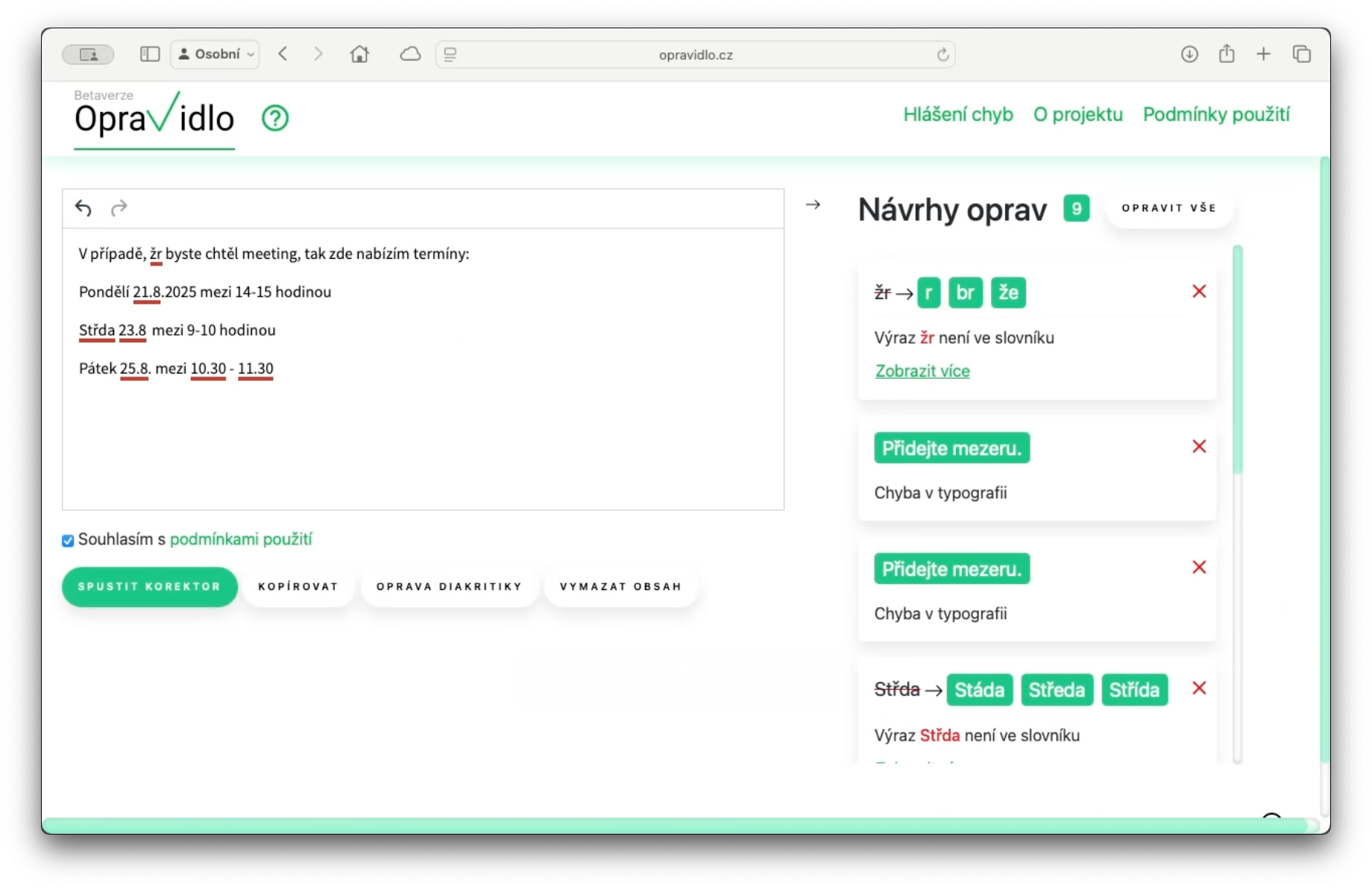
Opravidlo.cz can detect more mistakes than a regular Word check and is useful whenever you need 100% confidence that your Czech is correct. The advantage is that it’s free online and you don’t need to install anything. However, after the automatic proofreading, I recommend going through the text again with your own eyes – while the AI proofreader will help you find most errors, the final check is always up to the human.
Example of using AI 3/10:
Translations into foreign languages
Do you need to quickly translate a text into a foreign language or from a foreign language into English? Today, AI translation is often indistinguishable from the work of a native speaker. A great tool is DeepL, which offers translations in high quality. You don’t even need to create an account at DeepL.com – you can translate text up to about 1500 characters in one click for free. Just paste the original text into the left window, select the target language and a high-quality translation will immediately appear in the right window. You can then fine-tune the text or copy it for further use.
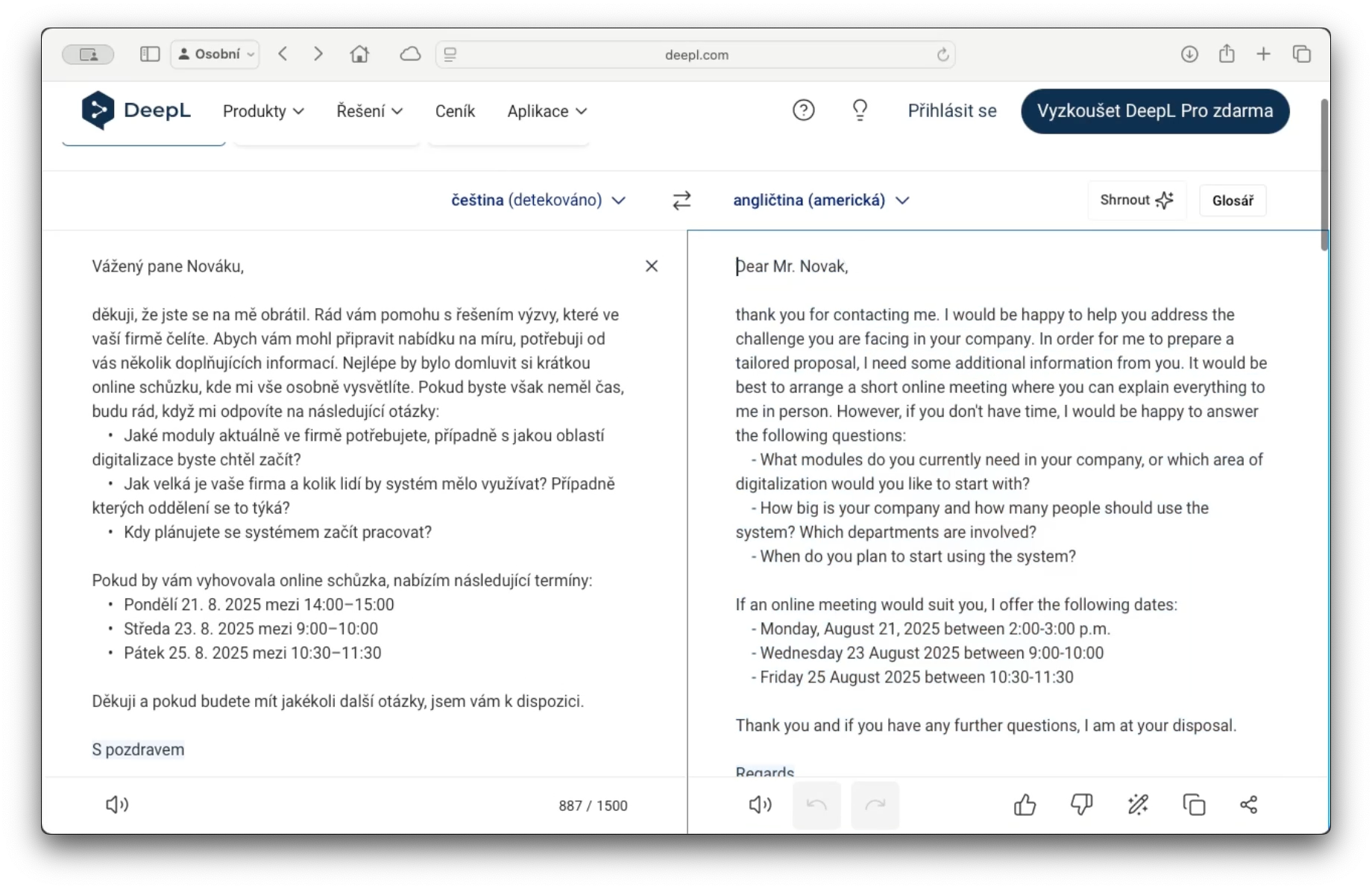
For everyday translations, ChatGPT also works well – just formulate the prompt, insert the text to be translated and let the AI work. The quality of ChatGPT’s translation is sufficient for most purposes, although DeepL leads in accuracy and preserving subtle nuances of meaning. On the other hand, ChatGPT can translate longer texts beyond DeepL’s limit, and you can converse with it directly about context or requirements (e.g. “translate the text while keeping the tone informal”).
Tip: If you are not sure whether the translation matches the original meaning, try having the AI translate the text back into English and compare the two Czech texts. This back-check can reveal any shifts in meaning.
Example of using AI 4/10:
Quick summary of long texts
I’m sure you know it: you find an interesting article or document of a few thousand words, start reading it – and after a long time you find that you didn’t find what you needed. AI can save you time by quickly “flying through” a long text for you and summarising its main ideas.
For example, ChatGPT can be asked to create a short summary from a web link or embedded text. Simply type a prompt along the lines of: “Summarize the content of the following article in five sentences. Article: [link]” . ChatGPT will review the article (or you can copy it manually if the AI doesn’t have access to the internet) and return an extract of the highlights in a moment.
Shrň mi prosím tento článek do 5 vět. Chci vědět, o čem je, a odhadnout, jak dlouho mi zabere přečíst si ho celý.
Následuje text nebo odkaz na článek apod.Such a summary will quickly tell you whether it makes sense to go into the text in detail or whether the information you are looking for is not there anyway. You’ll appreciate this approach when you’re doing research, for example – instead of reading ten long articles, you’ll let the AI “read” them first and extract the relevant points.

Example of AI usage 5/10:
Document and contract analysis using AI in SmartFP
Do you spend hours reading through long contracts or documentation to get the information you need? AI can make it much easier for you to navigate through large documents. For example, we’ve integrated AI into the Contracts module in the SmartFP platform, where it helps you quickly find answers to various questions from the contract text.
The procedure is simple: open a specific contract in SmartFP (e.g. as a PDF attachment), click on Analyse AI document and write a question about the contract in the prepared field. For example, “What is this contract about?” or “How can the supplier cancel the contract?”. The AI will scan the entire contract text in seconds and return a summary answer with relevant information. That way, you don’t have to read every word yourself – the AI does it for you and only picks out the important ones.
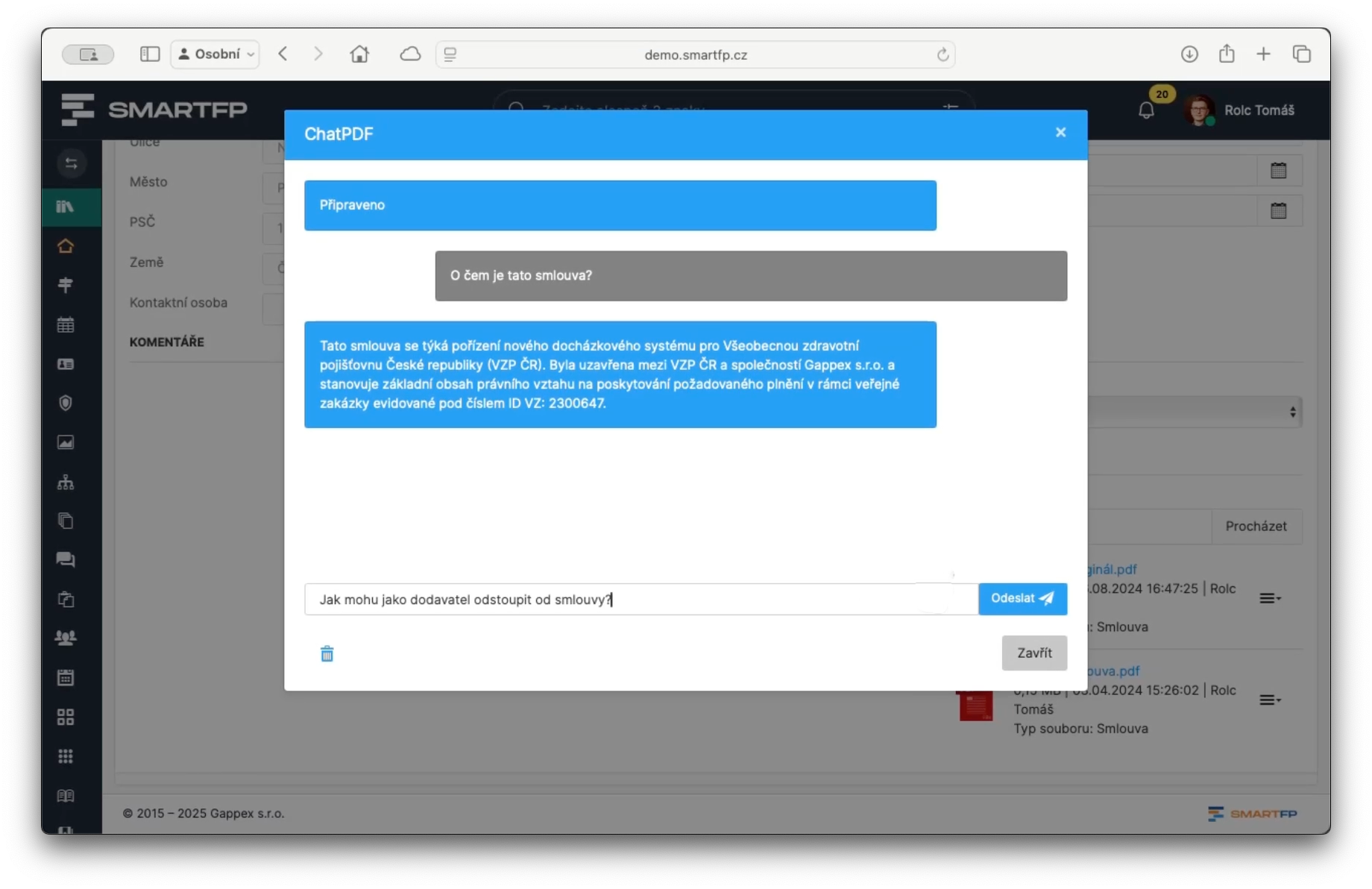
This way, you can ask any questions you want about the content of the document and the AI will “pull” the data you need from the depths of the text for you. This saves time and reduces the risk of missing something. We currently use this feature for contracts, but a similar principle can be applied to any other long text (reports, manuals, laws, etc.). If you’d be interested in AI in other SmartFP modules, get in touch and we’ll be happy to demonstrate.
Example of AI usage 6/10:
Bulk personalised correspondence
Do you need to send out an email to more people, but want everyone to receive a message with a personal touch and relevant data? With the help of AI, you can speed up the preparation of mass personalized mailings. We’ll demonstrate this with the example of combining Excel, Word and ChatGPT.
Imagine you have a list of marketing contacts in Excel – for example, columns Name, Last Name, Email. You want to address each one by name in the introduction (e.g. “Dear Mr. Novak / Dear Mrs. Novak”) and use the correct word forms in the text according to the gender of the addressee. However, you do not have the gender information or the appropriate salutation in Excel. You can have the AI fill in this information. Just take the list of first and last names and give ChatGPT a prompt to assign a gender to them and create the correct form of address.
Doplň mi do tabulky pohlaví na základě křestního jména a příjmení (většinou česká jména — odhaduj podle kalendáře nebo podle koncovky příjmení). Zároveň doplň oslovení: “Vážený pane příjmení” pro muže a “Vážená paní Příjmení” pro ženy, jak je uvedeno v příkladu. Nezapomeň, že u oslovení musíš dodržet Vokativ (5. pád) a doplň mi všechno.
V češtině je typicky pravidlo:
příjmení končící na -k, -h, -ch, -g → přidáš -u (procházka → procházko, Svoboda –> Svobodo),
příjmení končící na -r, -n, -l → přidáš -e (Kučer → Kučere),
příjmení na -a, -e, -i, -í, -ý většinou zůstávají stejné,
ženské příjmení (často končí na -ová, nebo je to „měkké“ příjmení) se neskloňuje.ChatGPT will go through the list and return a completed table in a few moments – each name will indicate whether it is male/female, and the correct form of the address (e.g. “Mr. Novak” / “Mrs. Novak”). Check the result again, especially for less common names or for inflections of fifth-floor surnames. In my experience, the AI hit about 85% of the items correctly, and for the rest a minor manual correction was sufficient.
Now you have a column in the table with the address and gender. The next step is to use bulk correspondence in Word. In the prepared email template (for example, a letter to clients), you mark the place for the salutation and insert the field corresponding to the Salutation column from Excel. Next, you set conditions for different word forms by gender – for example, instead of the sentence “Thank you for attending…” you use a condition: If gender = male, insert “attended”, otherwise “attended”. Treat other parts of the text where the masculine and feminine forms differ in the same way.
When you’re all set, you link Word to your Excel data and let the document merge into your emails. Word will generate an individual letter for each recipient: adding their name, salutation and the correct word forms. Finally, just send all the emails with one click. Recipients get a message that looks like you’ve written to each one individually – yet you’ve created it all at once with the help of AI and smart Office features.

Example of using AI 7/10:
Idea generation and brainstorming
Did you run out of ideas when writing text, coming up with a slogan or even a post on the net? Engage AI in brainstorming.ChatGPT can help you generate different variations of wording, titles or even jokes to lighten up your communication. Just describe the context to it and ask for a few creative suggestions.
For example, I personally enjoy the way Ryanair communicates on social media – with harmless humour, making fun of customers (but only those who have done something wrong themselves). I wondered what a similar tone of humour would look like in our environment. So I asked ChatGPT to generate three funny messages for the site’s error page about losing internet connection, in the style of Ryanair’s communication. For good measure, I also inserted specific examples of Ryanair posts into the prompts for inspiration.
Napiš mi česky 3 vtipné komentáře na Facebook ke snímku obrazovky z naší aplikace, kde se kvůli výpadku internetu objeví chyba. Styl: ironický, stručný, lehce provokativní — podobný komunikaci Ryanair, ale přizpůsobený softwarové firmě. Text má jasně naznačovat, že problém není na straně aplikace, ale u uživatele (ztráta internetu). Inspirace: Ryanair — „airport dads are the real golden retrievers“, „good morning to passengers who can fly 45 minutes without using the toilet“.ChatGPT promptly offered me three variations of funny catchphrases to use on the error page. I was pleasantly surprised by the result – the catchphrases were apt and funny, exactly in the spirit of the brand we were emulating. Similarly, you can use AI to come up with ideas for advertising slogans, alternative wording for paragraphs of text, suggestions for product names, calls to action, and many other creative tasks.

Example of AI usage 8/10:
Simulating interviews and preparing for meetings
Do you have an important conversation coming up – perhaps a job interview, a difficult business meeting or a request for a raise? You can prepare for that too with the help of AI. ChatGPT not only gives you general tips on how to handle such a situation, but you can also simulate a model interview with it.
Think of it as a mock role-play: you ask the AI to act as a counterpart (e.g. a demanding boss in an interview), and you try to answer its questions yourself. ChatGPT will respond as a real human might – asking follow-up questions, objecting, asking for details. This will allow you to try out different scenarios and prepare better answers. When the real conversation comes, you’ll be calmer and more confident because you’ve “touched” the communication with the AI beforehand.
All it takes is a simple prompt, for example: “Get ready to talk to me. You’ll be the recruiter, I’ll be the candidate. Please start with a common interview question and then respond to my answers.” Within seconds the simulation will start and you can practice until you are satisfied.
Example of AI usage 9/10:
Improving the style and tone of the text, engaging the reader
Do you have a draft text that you know isn’t quite there yet – but you can’t tell exactly what it’s missing? Ask the AI for an opinion. ChatGPT can analyse your text and suggest what could be improved. For example, you might ask it, “Can you advise how to edit the following text to make it sound more professional and punchy?” and insert the text in question. The AI will list specific recommendations – for example, shorten long sentences, replace passive sentences, add a call to action, etc. You can then edit the text yourself according to these suggestions, or let ChatGPT create an improved version.
You can also specify the style of the final text – for example, “rewrite the text to be less formal and more emotional (emphasis on positive feelings)”. The AI will rework the text to the desired tone. Don’t be afraid to try different variations until you’re happy with the result.
Another trick to make your text come alive and draw the reader in is to have the AI suggest appropriate questions. If your text is long or challenging, a few simple questions inserted in the right places can keep your audience’s attention.
Ask ChatGPT: “Think of some inquisitive questions I can insert into this text to better engage the reader”. Depending on the content, the AI will suggest questions you can use in the text – often slightly provocative or thought-provoking. If you ask such questions during your article or presentation, readers feel more drawn in and think more actively about the content.
Example of AI usage 10/10:
Fun playing with text (emoji and co.)
Finally, we’ll show that AI doesn’t just have to be used for serious work – it can also be a great source of fun and creativity. You may have noticed an internet trend where people communicate entire stories using only emoticons. They take a well-known short story or movie and translate the plot into what’s called emoji language. Of course, even this can be done with one click with the help of AI.
I tried it with the classic tale of Little Red Riding Hood. I gave ChatGPT a prompt asking it to translate the text into the language of emoticons that will express the plot. Chat subsequently wanted to see the text of the fairy tale – so I inserted a shortened version of Little Red Riding Hood. Within seconds, the AI started generating an emoji sequence that actually retold the entire story.
Převeď text do jazyka emotikonů (bez textu, pouze emotikony, které vyjadřují děj). Nejdřív si prosím vyžádej text, který mi převedeš.
Následuje text nebo odkaz na text (lze použít i přílohu).This created a picture “text” from which you would surprisingly know what kind of fairy tale it is. On purpose – would you know from the following series of emoticons that it is Little Red Riding Hood?

You can try many similar playful experiments. It’s not something you’d use every day at work, but it shows how flexible generative AI can be. And who knows – maybe you’ll use emoji storytelling to liven up your presentation or lighten up your social media communications one day.
What to take away from this piece
Artificial Intelligence is not just a buzzword, but a practical tool for everyday work with texts. It can save you time when writing emails, help you with translation, check spelling, summarise a long document, help you formulate your thoughts or give you a new idea for your speech. At the same time, the best results come from a combination of AI and human – your expertise and control, along with the AI’s speed and creativity, make a very powerful pair.
Today’s episode showed you 10 specific ways to use AI when working with text. Which of them interested you the most?Try it out and let us know how it worked in your case. We’ll be happy for feedback and other tips in the comments.
Comparison of AI tools for working with text
| Tool | Functions | Benefits | Price |
|---|---|---|---|
| ChatGPT | Writing, editing, translating, summarizing and more | Versatile | free/20€/month. |
| DeepL | Translations | Very accurate translations, style | free/8.74$/month |
| Repair.cz | Spell and style check | Czech instrument | Free |
| SmartFP (Treaties) | AI as a complement to modules | Aimed at companies, secured | Ask for a demo and an appointment |
What awaits us in the next episodes
You can look forward to the next episode again on Friday, namely 27. 6. 2025. The topic will be image creation using AI. We’ll show how to easily generate images in a consistent visual style – whether for the web, a presentation, or social media posts. You will also learn how to “squeeze” original graphic ideas out of AI and how to put the resulting images straight into practice.
Subscribe so you don’t miss anything:
Recommendations in conclusion
If you have an idea for a specific topic that would be of interest to you, I’d be happy to hear from you. I’m creating this series for you – and with you.
